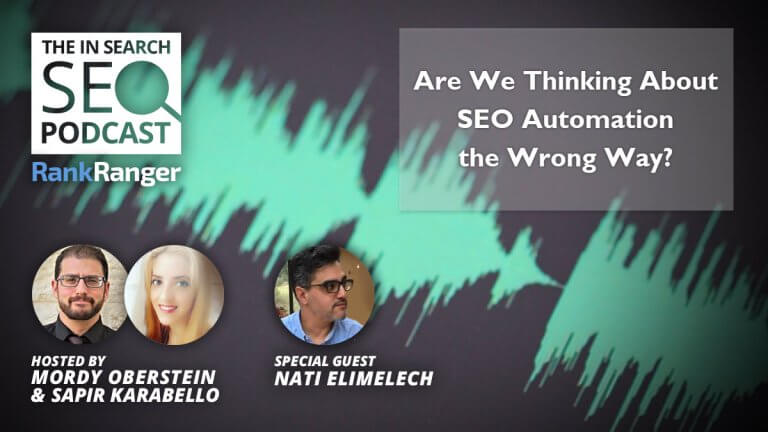 Marketing Intelligence
Marketing Intelligence
In Search Podcast: Are We Thinking About SEO Automation the Wrong Way?!

Don’t forget, you can keep up with the In Search SEO Podcast by subscribing on iTunes or by following the podcast on SoundCloud!
Summary of Episode 45: Diving Into Google’s News Algorithm & Advanced SEO Automation Tips!
This week we talk to the great Nati Elimelech, the CEO of SEO Israel, all about SEO automation:
- Why you’re really not taking advantage of SEO automation as you should!
- Who should be using SEO automation and when!
- How to make sure you don’t go too far & get too lost in the world of SEO automation!
Plus, we explore Google’s new “original source” algorithm modification and the complications that arise from it!
The Issues Facing Google’s Original News Content Preference [00:03:46 – 00:26:09]
Ever since Google announced its original news source preference, Mordy has been carefully assessing and analyzing the developments that have come out of it.
Here’s the timeline: On September 12th, Google announced that it has updated its algorithm so that original reporting will rank higher in Google search results. And this works. Mordy tested it out with some of the news Rank Ranger has broken over time and everything appeared to be in order here.
After this announcement, Mordy noticed the AP (Associated Press) does not rank anywhere on the SERP for current news content. You won’t find the AP above the syndicated outlets and you won’t find the AP below its syndicates. Why? What’s going on here? It was all so perplexing until Mordy saw an article on Search Engine Land. Others in the industry noticed issues similar to what Mordy saw. It turns out it all relates to canonical tags. Usually, the canonical points to the original source of the syndicated content. In the case discussed within the Search Engine Land article, the canonical was pointing back to itself and not to the original creators. It turns out, this is the common practice when using syndicated news content. The problem with the AP is that they are not canonicalizing to their own news content. Unlike a newswire like Reuters, the AP does not point to itself as the original source via the canonical. At the same time, all of the sites using the AP’s content are using the canonical and using it to point to themselves as the original source. Thus, Google has a hard time understanding that the AP is the original source of the news content in question.
Alli Berry of the Motley Fool, said they have seen the same problem with their news content. They do use the canonical tag yet Yahoo ranks above them as Yahoo also uses the tag, but to point to themselves as the original source. Not only that, but Alli told Mordy that the NASDAQ uses their articles in syndication, uses canonicals to point back to the to Motley Fool, but still ranks better than they do on the SERP!
Something is out of whack.
Mordy was curious why Google doesn’t check who the original content source is by utilizing the timestamp. Just check which article has the earliest timestamp and you have the original! (Though, it’s probably not that simple.) And even if that won’t work, then check the author. If hundreds of articles are saying, “So-and-so from the AP wrote this,” you would think Google will catch on. And it’s not like Google has a blind eye to this. They know what’s happening.
And the biggest question of them all is: Why isn’t the AP using the canonical tag? Mordy believes the AP is doing this on purpose. The AP is actually owned by the publishers themselves, like a publisher’s union of sorts. The publishers don’t want the AP to rank above their content which is why the AP doesn’t have canonical tags… according to Mordy’s theory.
Where does the AP show up on the SERP? Old queries and broad queries. Meaning, keywords related to news stories of yesteryear and keywords that broadly related to news content.
Per Mordy, it behooves Google to get a little more complex in how they look at original news content.
The Importance of SEO Automation: A Conversation With Nati Elimelech [00:26:09 – 01:01:55]
Mordy: Welcome to another In Search SEO podcast interview! Joining us today is the CEO of the foremost SEO agency in all of Israel, SEO Israel. He’s an accomplished SEO, he’s a serious SEO, he is Nati Elimelech.
Welcome!
So you have a dog and you have a cat, but you hate the cat…
Nati: Hate might be too strong of a word. It’s more I dislike the cat. Basically, my dog is an angel, very lovable, and is everything that’s good in the universe while my cat is a hellspawn which ruins everything.
M: But you must still love it as you haven’t gotten rid of it.
N: I don’t know. Maybe it’s Stockholm Syndrome, I’m just too invested in it to get rid of it now.
M: So we’re going to be talking today about one of my favorite subjects, SEO automation (as Rank Ranger is an SEO automation tool). To make sure we’re all on the same page here, when we say automation in SEO, what does that mean?
N: For me, SEO automation is the process of freeing up a lot of time spent on drone work and reinvesting it in quality work. When you speak of Rank Ranger as an automation tool I don’t see it like that, I see it as a standard for our practice.
The way I see it SEO has four major aspects to it. 1) Content and optimization, 2) Technical infrastructure, 3) Online reputation and links management, and 4) Monitoring (finding and fixing what’s broken, performance issues, sudden metric drops, etc.). So when I discuss SEO automation I’m referring to the monitoring part. I’m talking about manual, repetitive tasks that are part of SEO work and making sure as little time is being used on this.
It means getting the data from the tools we use on a daily basis like rank tracking services, Google Analytics, Search Console, Screaming Frog, etc., and doing something with that data. It’s not just getting these values, it’s doing something with it, making sure the next step in our strategy is well on its way.
M: And you think this applies to everyone across the board? From SEO agencies to freelancers?
N: I think so, yes. It’s extremely helpful on scale, but also as a freelancer you don’t have a lot of time in your day so you need to minimize whatever you can with these menial tasks so you can focus on what helps and what’s effective.
M: So it’s impossible to do SEO without some form of automation, right?
N: I wouldn’t say impossible, I would say it’s a tradeoff. If you don’t automate things you will end up not doing them. Let’s say you’re a large SEO agency like ours with hundreds or thousands of checks to perform and these small actions can add up. If you’re pressed for time one of three things happen: 1) You get more manpower (which never happens, 2) You can skip some of these tasks or at least don’t do them at the scale you like, or 3) You put the time in at the expense of other burning issues you wanted to sort out or that beautiful piece of content you wanted to start working on. Either way, something suffers. SEO people are very busy. I’ve never met an SEO person who wasn’t busy during work hours.
M: At what point do you weigh in the cost of a tool versus the time it saves you?
N: How are you with numbers? Do you like math?
M: I have a calculator so go ahead.
N: This might surprise you. Let’s calculate how much time menial tasks really take. Let’s talk about testing page speed scores (and we’ll assume it matters as much as people think it does). So Mordy, how long do you think it will take to test page speed?
M: A couple of seconds.
N: Ah, but in actuality, it takes longer. I can tell you that everyone thinks that a lot of tasks take only 5-10 minutes. People think that a task takes less time than they actually do. It’s called the Planning Fallacy.
Let’s breakdown what you need to do when testing page speed score. We think it’s only one action, but when broken down it’s really a lot of smaller actions. What’s the first step in the process?
M: Load the URL into the tool.
N: Right, but the first step is to open a tool like Google Drive and get the URL you need to monitor. You need to find the file, find the URL on the list, and that can be two minutes. Next, you have to open the Page Speed Insight tool, paste the URL, and start the audit. An audit can take from 30 seconds to over a minute. And all that can take let’s say another two-three minutes. Next, you get the score and record it. Then based on the score you have to do something. Let’s say if it’s less than 65 on mobile, you will have someone from the tech team have a look. To start that, you will need to send the tech person an email, or set up a task on your project management system, and assign it to the correct person. And that step can take about seven minutes. So to sum up, that’s 20 minutes per URL. In the end, if you want to monitor 100 URLs a week, that’s 8,000 minutes of work time per month or over 130 hours! That’s almost a fulltime job! In our agency, we monitor thousands of URLs.
If you do it right, scale doesn’t matter. You can analyze a hundred, or a thousand URLs the same time it takes to analyze just one. That’s the point of SEO automation in my opinion.
M: That’s a great point, but there have to be drawbacks. You have so much automation and data coming your way. How do you know what to pick out? How do you know what to focus on? How do you not get lost in all of that data?
N: Actually, I use automation to avoid looking at too much data. I don’t want to look at all the data, I only look at certain data points that the system triggers for me to look up. For example, I don’t need to look at every page speed report, I only need to be notified of the ones that are below the threshold. So automation actually saves me from looking at too much data and getting lost.
M: That’s a good point. So you use a lot of alerts?
N: Yes, and the relevant person who needs to take care of it will be automatically notified and assigned a deadline. A lot happens. Alerts are just the basic output of the process.
M: To ensure you’re using a tool to its fullest potential, how do you make sure each person on your team is properly trained to use the tool?
N: We do use a lot of tools and I don’t make sure that everyone on the team knows how to use every tool. I’m a firm believer in expertise. Pick a thing you’re good at and stick to it. In our company, data automation is handled by dedicated people.
M: So you have one person doing site audits, etc.?
N: Yes, we have a technical SEO team that only works on technical. They know nothing about content and our content people only focus on content. I’ll tell you, I’ve met a lot of great SEO people, but I’ve never met someone who is absolutely great at everything.
I see a tremendously high chance of inefficiency here. I’m sure there are a lot of people out there who are spending a lot of money on tools where the tools are not being used to maximum value because the staff using those tools are not properly trained.
M: That’s very true. How long do you think it takes to master an SEO automation tool? As time goes on, and I can speak for Rank Ranger, that the tools are only getting more robust, more complicated (in a good way), and just doing more.
N: There is a learning curve. I don’t think anyone will learn a tool perfectly because once you get used to a tool you have about a month of actually learning the tool perfectly. Once when you’re there, you probably won’t be caught up with all the new features and updates. You can always be chasing those new features inside the set of tools you have. It never stops and never ends. That’s the reason I love SEO, you never stop learning!
M: That’s true and very unique about the industry.
N: Right, I never had another job that keeps me on my toes all the time.
M: This next question is partly out of self-interest. What do you think the SEO tools should be doing that’s different from what they’re currently doing?
N: I think that’s something that Google Analytics started and a lot of PPC tools have been doing which is pushing more insights instead of just findings. I think what tools are missing right now are artificial intelligence and machine learning, but I assume this is something they will catch up on in the next few years.
M: Right, us here at Rank Ranger have been more invested in insights for the past two years or so. Do you think the insights that are out in the SEO industry are really actionable? Feel free to be critical.
N: No, I don’t think so. We’re just not there yet.
M: Do you think the only way to get there is AI and machine learning?
N: Mostly, yes, but some part of it is the industry itself not agreeing what you need to do in certain cases. You have technical SEO and content SEO so a lot of professionals view things differently. Even if you had insight, there would always be one part that is of personal opinion whether it’s from experience or accumulated knowledge. There’s always that thing that makes every single SEO I know work differently than everyone else in the industry.
M: Yeah, and I believe there’s an issue of us relying so much on what Google says, on the data, and this and that. I think the thought of just using your intuition can get lost.
N: You’re absolutely right. Whenever we try to approach an SEO issue, we try to think of what’s behind Google’s thought process. What are they after? What do they want us to do?
M: You think that automation is largely ignored. I’m curious why you think it’s being undervalued.
N: Yes, and I will tell you. For some reason, automation is generally related to marketing or sales-related activities. I think people don’t realize that automation isn’t about data, it’s about redundant processes, wasted time. If you take the time to create that infrastructure you will save tons of time.
M: At the same time, isn’t there a bit of over-reliance on some of the automation processes? For example, I still think you need to visit the actual SERP as there’s nothing like seeing the real SERP, especially where trying to uncover user intent is concerned. And you would not learn these things by just using automation.
N: You’re absolutely right. I have some rules on what to automate and what not. For automation, I have one simple rule: If it’s dumb, if it’s simple, and if it’s repetitive, automate it. If it’s dumb means there is no thought process, no thinking needed. If you need to observe user intent, no automation service will give you that data.
M: Not yet.
N: Is that a spoiler?
M: It’s a spoiler that you have to hold on to for a bit.
N: Alright. So looking at the SERP and user intent isn’t something you should be automating. If it’s simple things like pasting a URL into a tool, checking and comparing KPIs, etc. If you need to think about it, don’t automate it. That’s basically it.
M: What’s your decision process when looking at a tool?
N: The most important thing aside from the data is that I can pull that data into an API. Basically, automation is taking data from Point A, doing something with it, and then pushing it into Point B, an action or follow-up action. I don’t want to use a GUI, nor plug-in. Without wasting my time on clicking on stuff. I don’t like wasting time on clicking on stuff. I want to see the data my own way using my own methods without clicking on stuff. Let other people use your abilities the way they want.
M: One more final serious question. What are some out there things you’re doing with SEO that may surprise people?
N: Whenever we win a deal for a new client, we actually use Rank Ranger’s API to automatically open a new campaign. We assign that campaign to a project manager. We assign all the relevant data, send emails, onboarding, etc. Everything is automated up to the point where you have to use your mind like keyword research.
Basically, if there’s one thing people get out of this is that you can automate whatever. You can do whatever you want, you just need to be creative.
Optimize It or Disavow It
M: One or the other, no in-between. You could either have the best SEO automation toolset ever seen on God’s earth or a really good SEO person on your team. Which would you rather?
N: In all honesty, I will take a brilliant mind over a tool any day. Great minds have great ideas that can change your life. Tools are just tools and in the wrong hands are just another expense.
M: I couldn’t agree with you more.
Nati, thank you so much for coming on.
N: Thank you for having me.
SEO News [01:06:27 – 01:10:32]
Meta Titles on Desktop Have Gotten Shorter: As reported by us, Rank Ranger, titles on the desktop SERP are about 5 characters shorter.
Google Has Removed Self-Serving Review Rich Results from the SERP: Google has put an “end” to what it calls self-serving reviews. You can no longer use schema to have the ratings/reviews that appear on your own site show as part of a rich result on the SERP.
To quote Google, “reviews that can be perceived as “self-serving” aren’t in the best interest of users. We call reviews “self-serving” when a review about entity A is placed on the website of entity A.”
Google Released a New Video Feature: Google has launched “In this video” for some videos. Appearing within a video card, the feature is a carousel of the sub-topics discussed in a video. Users can click on a sub-topic to move to that spot within the video shown!
Google Search Console Released a New Report: Search Console gets some new data. A new report shows you errors with your Structured Data with a specific segment for breadcrumbs.
SEO Fun Send-Off Question [01:10:32 – 01:13:15]
Where would Google go on vacation?
Sapir suggested that Google travel to North Korea to stay away from the internet. Mordy decided on the Bermuda Triangle as it is just as mysterious as Google.
The In Search SEO Podcast will be taking a month’s break and will be returning on November 5th. See you then!
The #1 keyword research tool
Give it a try or talk to our marketing team — don’t worry, it’s free!






